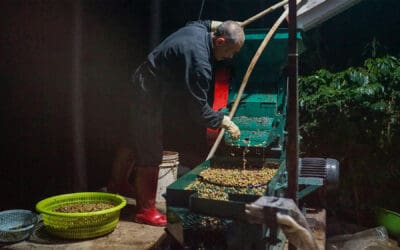The Fair Trade coffee movement transformed how we think about coffee production and farmer equity. But as with any solution, there are unintended consequences to consider.
After two decades working with producers across Latin America’s coffee belt, I’ve observed a complex reality: Fair Trade certification, while revolutionizing the economics of coffee, has had unexpectedly mixed environmental impacts that we need to confront.
Let’s cut through the wash of marketing impressions and examine what actually happens at origin. Fair Trade certification requires producers to meet basic environmental standards – prohibiting the most harmful pesticides and encouraging shade-grown cultivation. However, the certification’s primary focus on economic justice has created unintended consequences for our planet.
Consider the water-intensive wet processing method, still dominant among Fair Trade producers. A typical wet mill processing one ton of coffee cherries uses up to 2,500 litres of fresh water. This wastewater, laden with organic matter, often flows untreated into local watersheds. While some Fair Trade cooperatives have invested in water recycling systems, many lack the capital for such improvements despite receiving premium prices.
I’ve witnessed this firsthand at mills across Guatemala and Peru. The bitter irony is that Fair Trade’s price floors, while providing crucial economic stability, can sometimes reduce the urgency to modernize toward more sustainable processing methods. When producers are guaranteed above-market prices, the economic incentive to invest in water-efficient technology is blunted.
This flies in the face of evidence indicating that social welfare programs in combination with sustainable practices can increase crop yields and quality of product. You can read more about this in Cliff Beecham’s article, Fair Labour Practice and Sustainable Farming Methods: The Hidden Pattern.
However, there are promising solutions emerging. The Colombia-based Cenicafé research center has developed ecological wet processing systems that reduce water usage by up to 90%. Some forward-thinking Fair Trade cooperatives in Costa Rica have pioneered closed-loop water recycling, turning what was waste into natural fertilizer.
For home coffee enthusiasts committed to both social and environmental sustainability, here are three actionable steps:
1. Seek out Fair Trade coffees from cooperatives that have invested in eco-processing. Look for terms like “ecological wet mill” or “water recycling” on packaging and marketing materials. Companies like Counter Culture Coffee and Equal Exchange are leading the way in transparency about their producers’ processing methods.
2. Support roasters working directly with producers to fund environmental improvements. Make a point of asking, for instance, if they provide low-interest loans to partner farms specifically for eco-processing upgrades.
3. Engage with your favourite coffee companies. Ask about their producers’ processing methods and water usage. You will be surprised how consumer pressure drives change in this industry.
The environmental challenges in Fair Trade coffee aren’t insurmountable, but they require our attention and action. The next evolution of ethical coffee must unite social and environmental sustainability. As industry professionals and conscious consumers, we can drive this transformation.
The good news? The solutions exist. Water-efficient processing technology continues to advance. The question is whether we’ll create the economic incentives and support systems to implement these solutions at scale.
Want to dive deeper into sustainable coffee processing? Subscribe (if you haven’t already) to The Coffee Authority Weekly as I’ll break down the specific technology behind ecological wet mills and explore how home roasters can apply water-conscious principles to their craft in u-coming posts.
Note: This post draws on research from the International Coffee Organization’s 2023 Sustainability Report and field studies by the Coffee Research Institute. While Fair Trade statistics are drawn from FLO International’s annual reporting, specific water usage figures may vary by region and facility.
As always, share your thoughts (with me and your social networks): How do you balance environmental and social considerations in your coffee purchases? Have you visited any coffee processing facilities? Let’s discuss in the comments below.



0 Comments